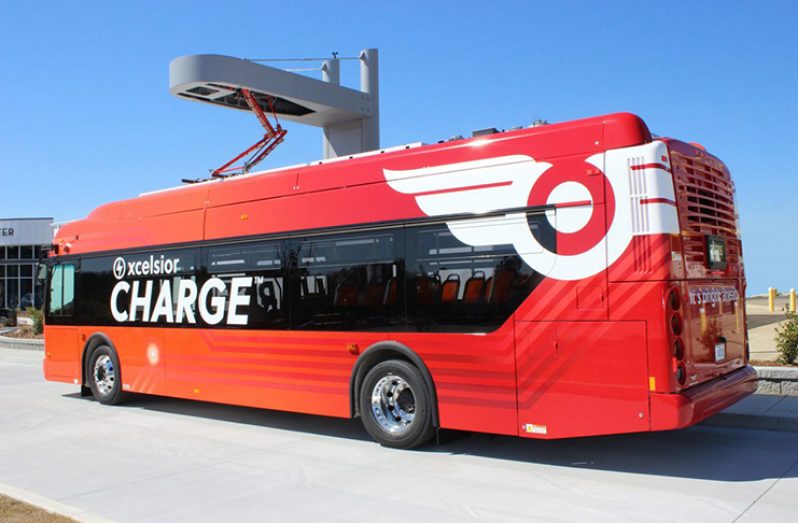…investors to plug US$2M into metro bus service
GUYANA may soon see the introduction of a US$2M high-tech metro bus service into the public transport system should plans follow through with a new company on the market, Guyana Metro Bus.
The company is set to be fully operational by June 2019, according to one of its investors, Robert Millington, who sat down with the Guyana Chronicle on Wednesday to disclose the plans and reasoning behind the initiative.
After leaving Guyana in his teens and spending 24 years in the U.S. Military, Millington retired in 2010 and returned to Guyana in 2013, when he earlier on set up another business, the American Eatery in Eccles, East Bank Demerara. There are two other individuals investing in the company who reside in the United States, while Millington serves for the time as the local representative.

The trio embarked on the mission after they observed, from abroad, the gradual deterioration of the level of service provided in the country’s transport system. This Millington listed as self-imposed fare hikes, physical scuffles over passengers, loud and lewd music, speeding and more, stating: “All of those things forced us to consider what we can do.”
As such, in 2019, the Metro Bus service intends to initially operate five routes which are: Georgetown to Mahaica; Georgetown to Linden; Georgetown to Parika; Georgetown to Timehri and Georgetown to Wales.
To service these routes, the company intends to import seven buses, either from North America, Brazil or China with five to operate the above- mentioned routes and two on standby.
The buses will not rely on fuel, but will be powered by electricity, and charged through a charging station which comes along with the bus.
Millington stated that given Guyana’s current energy challenges, the company will be leaning on the Guyana Power and Light (GPL) to make its upgraded services available.
“We’re trying to work out with them to supply the electricity to charge the bus. When that doesn’t happen, we’re going to have generators to back up GPL…but we’re hoping that GPL improves. We saw the newspaper story which said they’re borrowing 20M and it would be nice if that works, because [a] business like mine that depend on electricity will be better,” he explained.
The buses can hold up to 64 passengers with 32 seated and 32 standing, if need be, by utilising handholds. Speaking to what the new service will cost consumers, Millington said: “Initially, [the prices will be] the same as the minibuses, because we want people to try it. If the bus is there and you want to get home, you can come on the bus, you don’t have to pay more. That’s the introductory price for the first six months, after that the prices are going to be higher by 20 per cent.
“We understand that the people that are travelling in the minibuses, they don’t have a lot of money to spare. Even though we’re giving a better service, we also understand that we can’t double the price or triple the price from what the minibuses charge.”
This system also caters for the price variance currently paid in the public transport system by students and adults. The buses, depending on the route, will make up to 10 or 20 trips per 24-hour day guided by a specific time schedule, whether full or not, and will only be stopping at designated bus stops. Millington said that Metro Bus will be reaching out to various business organisations interested in constructing bus stops at strategic points, apart from those already in existence.
Meanwhile, the company is working to establish a bus terminal a short distance from the Stabroek Market Square and the process for this is progressing well.
When it comes to the payment system, the businessman said that persons will have the option to utilise a metro card or cash through an electronic machine. This is customary in developed countries such as North America, where the buses also operate without conductors.
However, for this to occur in Guyana, Millington says that the Metro Bus Company will need to consult the Ministry of Business as, by law, buses are mandated to have conductors. “We won’t have any conductors. The government says that buses have to have conductors [so] we have to engage with the Ministry of Business to work that out, either to change the law, or to have an exemption from the law,” he said, adding that this needs to be finalised before it is okay for the company to operate.
Apart from this, Millington said that the other procedure includes registering or incorporating the company in keeping with the country’s laws.
By 2019, MetroBus will begin advertising for a staff of 15 drivers, who must meet the necessary criteria to provide professional service.
Meanwhile, some five retired overseas Guyanese with experience in fixing electric metro buses will be utilised as the maintenance crew who will work to train some 10 locals, such as graduates of the Georgetown Technical Institute (GTI), to gradually replace them. Other benefits to the bus service include a programmed speed limit to guard against speeding and, in the future, Millington says the company hopes to expand its services to Berbice, Essequibo and around Georgetown.
However, until additional roadways are developed, the bus service will not be able to divert from Guyana’s main roadways. “The Ministry of Public Infrastructure is doing what it can. However, the roads that we’re using, are big enough, anywhere we’re going the buses can fit. That’s why we’re not going east, west or round town, because the roads may not be ready and we don’t want to cause traffic jams, so to speak,” he explained.
Speaking about the level at which the government will assist in these plans, Millington said: “We’d like to do as much as we can on our own and identify areas where the government can help us, such as, land for our [terminal] and helping us to come to an agreement with GPL for supplying electricity to charge our buses, providing maybe some help in electric cost…the government has a lot of stuff on their plate, if we can do it without bothering them, that’s great; if we can reduce the amount of help we ask them for that’s even better.”
Just two days ago, the company created a Facebook page to advertise the budding company and already Guyanese have begun to express an interest, including those from the diaspora. However, some have begun to question whether the Metro Bus system will take away from the minibus operators. In response, Millington said the new service simply intends to offer an alternative to current options in the transport sector and takes into consideration the challenges customers currently face.
“We’re rescuing the customers from their grip. They [some minibus operators] don’t care about customers’ lives; they’re more worried about how fast they can get somewhere, so that they can go back and make more money. You cannot run a business like that and not care about people’s lives and not expect people like us to say ‘you can’t do that’.




.png)









